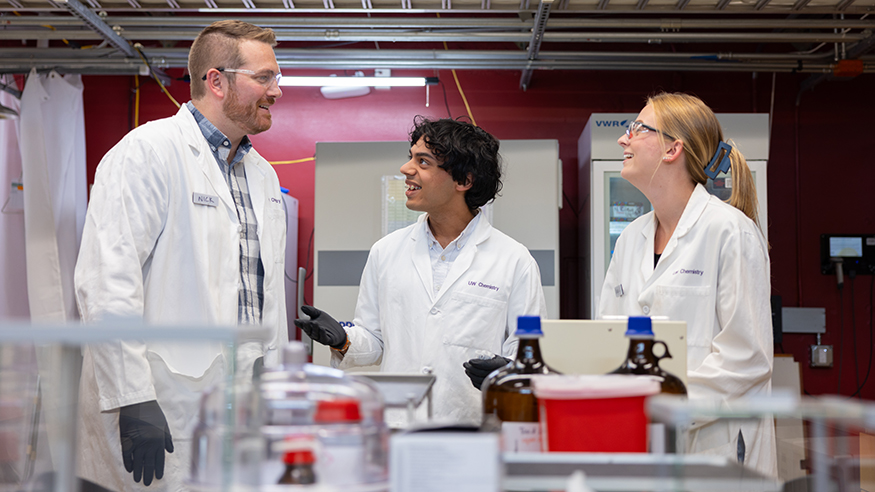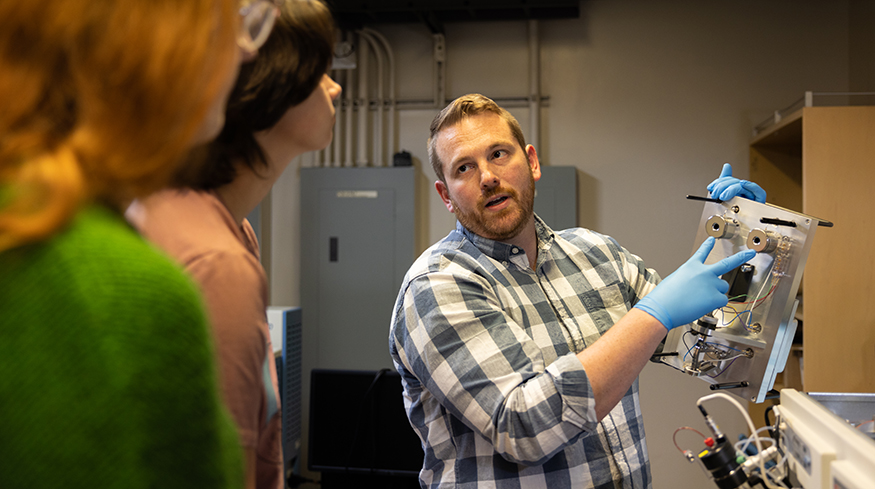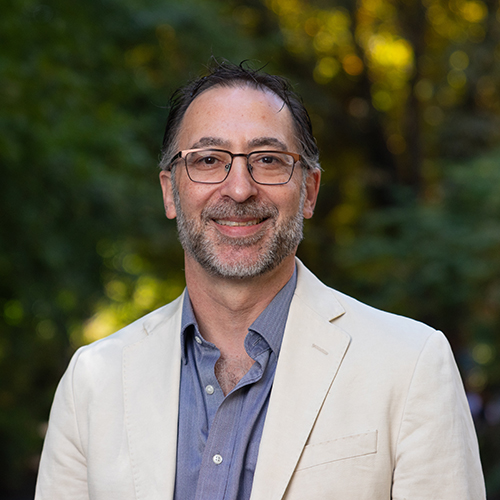
For most people, the word “sugar” brings to mind candy and cake and other sweet treats. But Nick Riley’s thoughts turn to proteins on the surface of cells, modified by sugars in a process known as glycosylation. His research aims to understand that process and what it means for our health.
Riley explains that sugar-modified proteins provide important information to our immune system. “We have very specific proteins that carry very specific sugars that tell the immune system, ‘This is a healthy cell, don’t kill it,’” says Riley, assistant professor of chemistry in the UW College of Arts & Sciences.
Unfortunately, the process does not always go as planned. In autoimmune diseases, a malfunction leads the body to attack itself. It might be that the cell has made the wrong type of sugar, or that the immune system failed to recognize the modified proteins. The opposite problem can also happen: Cancer cells can hijack the modified protein signature that tells the immune system a cell is healthy, tricking the immune system into leaving the cancer cells alone.
It’s clear that understanding the process by which sugars — known as glycans — modify proteins may lead to important advances in treating diseases, but getting to those answers may take a while.
“The complexity of glycosylation makes it really hard to study,” says Riley. “We know glycosylation is happening and we know it’s important, but the details of how it works are still to be figured out.”
Looking to Mass Spectrometry for Answers
To better understand how sugars modify proteins, Riley’s lab uses mass spectrometry, a well-established technique for identifying and studying cells and their proteins by measuring their mass. But existing mass spectrometry methods have not been sufficient to study all the features of glycosylation, so a central focus of the lab is adapting the technology to address their questions.

Riley first used mass spectrometry as an undergraduate at the University of South Carolina, working in a forensic chemistry lab. His adviser in the lab pointed out that most of Riley’s questions were about the instruments they were using. “He told me, ‘You should go to grad school for analytical chemistry and look into labs that specialize in mass spec, because that’s all you asked me about,’” Riley recalls with a laugh.
It was good advice, and it led Riley to focus on the methods used to measure and understand chemical processes. “I have always been a big believer that you can only understand what you can measure,” he says. “If you can’t measure it, see it, manipulate it, how do you understand it?”
The process by which mass spectrometry measures mass is complex, involving converting a molecule in liquid into a gas-phase molecule with a charge, and then applying electrical fields to manipulate and study the molecule. Sometimes molecules must be broken apart to measure the mass of their individual fragments, which provides more information than just the mass of the intact molecule.
I have always been a big believer that you can only understand what you can measure. If you can’t measure it, see it, manipulate it, how do you understand it?
“That’s a really effective way to sequence proteins,” Riley says. “But when proteins are modified by sugars, how you fragment things and sequence those combinations of sugar and protein gets a lot more complicated. Our focus is how to get our instruments better at measuring this combination of different types of biomolecules at the same time.”
Creating a Lab, Building a Team
Riley is quick to note that there are many other researchers also working on advancing mass spectrometry methods, especially in the Seattle area. “Seattle is a huge hub for mass spectrometry, not just in the US but in the world,” Riley says. “So for me, coming here was a dream come true. There’s so much here to be excited about.”
That was one reason Riley joined the UW Department of Chemistry in 2023. Another was the department’s emphasis on mentorship and interdisciplinary research. It helped that Riley was offered generous startup funds from the department and the College of Arts & Sciences to create his lab, which can be an expensive undertaking. The support made it possible for Riley to purchase a state-of-the-art mass spectrometer and other materials needed for the lab and to hire a research team that currently includes five graduate students and three postdoctoral students. “Ultimately people are the most important and most expensive part of this entire enterprise,” he says.

With a diverse team — some specializing in instrumentation, others with expertise in chemical biology — Riley’s lab already has dozens of research projects in various stages of development. As one of a relatively small cohort of mass spectrometry researchers who focus on cell-surface proteins, he’s excited to expand our understanding of glycosylation.
“One thing we are looking at is how a cancer cell starts in one tissue and then develops the ability to spread to other tissues,” says Riley. “We’re hoping this technology will allow us to measure over time and space how these cell surfaces are changing. If we can understand how they change and why they change, we can create targeted therapies to stop cancer from developing or spreading. And in the area of virology, there’s the potential to develop a vaccine that would allow your body to recognize a specific pattern of glycosylation and know that’s a virus you should attack.”
Developing treatments is a goal for the future, but right now Riley’s lab is focused on exploring more basic research questions.
“If you don’t have basic principles to launch from, it becomes very hard to develop solutions,” he says. “Basic research lays the foundation that allows creative real-world solutions to be born.”
More Stories

The Public Impact of Private Cities
Geography major Edwin Bai has researched private cities, developed by individuals and corporations, that "take the libertarian idea of low government regulation to the maximum."

The Curious Journey of Chinese Characters
Several Asian countries adapted the Chinese writing system—the oldest writing system still in use—for their own languages. In a new book, Professor Zev Handel shares how that happened.

Demystifying Quantum
In a physics course for non-STEM majors, Professor Miguel Morales teaches quantum mechanics without the advanced mathematics most quantum courses require.
